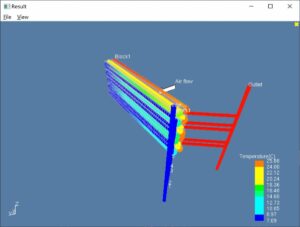Frank Gao and Kerry Song of International Copper Association, Yoram Shabtay of Heat Transfer Technologies and Harry Schmitz of The Kellen Company explain the role copper heat exchangers could play in safeguarding the atmosphere.
There is a growing realisation that something can be done about greenhouse gases (GHGs). As climate legislation gains popular support, governments, corporations and philanthropists are rallying around bold new targets to substantially reduce GHG pollution by 2030.
The European Union already has developed a “European Green Deal” [1], and in the United States, a full two-thirds of the population “thinks government should do more on climate” [2]. Globally, the Paris Agreement, within the United Nations Framework Convention on Climate Change (UNFCCC), established a framework for addressing GHG emissions mitigation, adaptation and finance [3]; and the Kigali Amendment to the Montreal Protocol seeks to reduce the consumption and production of hydrofluorocarbons. [4]
Although carbon dioxide emissions pose the gravest threat to the atmosphere, carbon dioxide (CO2) is not the only molecule that behaves as a GHG, when released into the atmosphere. The global warming potential (GWP) of hydrofluorocarbons (HFCs or ‘F-Gases’) is typically hundreds or thousands of times greater than the GWP of CO2. Synthetically produced HFCs are still widely used as refrigerants in air conditioners as well as in refrigeration equipment.

Frank Gao
The appliance design community can make significant contributions towards reducing GHG emissions. The use of eco-friendly heating and cooling appliances can aid the planet-wide transition to net-zero GHG emissions. Eco-friendly design of heating and cooling appliances supports decarbonisation, F-gas reduction and energy efficiency.
Electrification leads to decarbonisation
Net-zero GHG emissions cannot be achieved solely through the electrification of vehicles and heating and cooling appliances. Nonetheless, electrification is essential to decarbonisation. The use of heat pumps and electric vehicles allows for coal, natural gas and petroleum to be phased down and replaced by renewable energy sources, such as solar, wind and hydroelectric.
A heat pump is a cooling cycle in reverse. Heat-depleted refrigerant at high pressure is passed through an expansion valve and the cold low-pressure refrigerant flows into the evaporator, where it absorbs energy from the environment. The warmed refrigerant then enters the compressor, which performs work on the refrigerant, further increasing its temperature and also its pressure; the hot refrigerant is “pumped” or transported to the condenser, where it is used to heat spaces or water. In this manner, as the cycle repeats, the heat-energy gained by the refrigerant at the evaporator and the work energy gained by the refrigerant at the compressor are released for heating.

Harry Schmitz
A well-designed heat pump can operate with a coefficient of performance (COP) greater than one. It typically can produce three times or more heat energy output than the electrical energy drawn by the compressor. In contrast, burning fossil fuels in a furnace or boiler is extremely inefficient: High-grade, high-temperature energy resources are used to produce low-grade, low-temperature heat energy, with a COP of less than one. This is wasteful of our energy resources!
Driving down F-Gas usage
The development of heat pumps is promising from an environmental perspective, but most heat pump appliances on the market today still use high-GWP hydrofluorocarbons. Most F-gases are non-flammable (A1). R32 is a mildly flammable F-Gas that has a GWP of “only” 675 (compared to 2,088 for R410A). Certain mildly flammable HFOs have very low GWPs and, therefore, R32-HFO blends can be developed with GWPs less than 675. Many OEMs now use R32 or R32-HFO blends as a means of meeting F-Gas regulations in the near term.

Kerry Song
R32, HFOs and HFO-R32 blends all belong to the A2L flammability subclass. They are considered flammable, hence the A2 designation, but their “burn rate” is slower than typical A2 refrigerants, according to certain standard tests. The A2L “mildly flammable” designation sits between the A1 and A2 designation and allows for less stringent use conditions compared to A2 (flammable) or A3 (highly flammable) refrigerants. The differences between A1, A2L, A2 and A3 safety classes are summarised in a “Factsheet” jointly published by the United Nations Environment Programme and ASHRAE [5].
For commercial refrigeration, the transition to hydrocarbon (HC) refrigerants is already underway. HCs, such as propane (R290) are natural, non-toxic refrigerants with no ozone-depleting properties and very low GWP. They are among the most climate-friendly and cost-effective refrigerants available.

Yoram Shabtay
The adoption of R290 in light-commercial refrigeration equipment is a remarkable success story for the reduction of refrigerant charge using MicroGroove technology. Smaller-diameter copper tubes allow for a given cooling capacity using less refrigerant.
Although R290 is an A3 (highly flammable) refrigerant, it was approved for use many years ago, subject to a charge limit of 150 grams (5.29 ounces). Manufacturers of light-commercial refrigeration equipment have been quick to transition to R290. This charge limit was enough to spur the design and development of a wide array of commercial refrigeration equipment, including cold display cases.
MicroGroove technology developed in parallel with the transition to low-charge R290 refrigeration equipment and is an enabling technology for many R290 refrigeration applications.
More recently, the International Electrotechnical Commission (IEC) voted to increase the charge limit for A3 refrigerants (for example, propane) from 150 to 500 grams in self-contained commercial refrigeration equipment. IEC standard 60335-2-89 is the basis for all other standards for commercial refrigeration equipment. This higher charge limit presents many opportunities for new commercial refrigeration technologies, as countries around the world develop their own guidelines based on the IEC standard in the years ahead.
The wide variety of designs of heat exchangers for refrigeration equipment makes the HXSim heat exchanger simulation software program from the International Copper Association (ICA) a valuable tool for appliance designers. Using HXSim, one can vary the tube size, pitch, fin type and density, and block dimensions of condensers and evaporators to match the heat exchanger performance precisely to the application. ICA offers this software free of charge to appliance designers, globally.

The HXSim design tool simulates the performance of a heat exchanger in a refrigeration system using smaller-diameter copper tubes with 500g of propane as the refrigerant
Figure 1 gives an example of a heat exchanger design for a refrigeration application using 500 grams of propane.
The importance of energy efficiency
Air conditioners require larger refrigerant charges than light-commercial refrigeration systems. Consequently, most OEMs have resisted highly flammable refrigerants, such as propane, and opted instead for R32 or R32-HFO blends. Nonetheless, especially in Asia, including China and India, air conditioners using propane as a refrigerant are being manufactured in volume.
As noted in the article, “MicroGroove Coils Span the Globe: Smaller Diameter Copper Tubes Thrive In India,” when the Bureau of Energy Efficiency revised its Star Labeling to encourage higher efficiency air conditioners in India, AC manufacturers began to specify condensers and evaporators that transfer heat efficiently [6]. Laboratory experiments showed that heat transfer coefficients (HTCs) are highest for small-diameter inner-grooved copper tubes compared to larger diameter tubes and smooth tubes. Higher HTCs result in more efficient AC systems that also use less material and less refrigerant.
MicroGroove coils – made from smaller diameter, inner-grooved copper tubes – deliver an unprecedented combination of compactness and energy efficiency. They are more affordable than traditional designs, because they use less material. Typical MicroGroove copper tube outer diameters are 7 mm, 6.35 mm (0.25 inch) and 5 mm.
MicroGroove copper tubes are the preferred tubes for India, owing to their corrosion resistance. A decade ago, larger-diameter copper tubes began to lose market share to aluminum, and a low point was reached in 2014. But the corrosion resistance of copper prevailed, and copper heat exchangers recaptured market share. The trend back towards copper has been dramatic, as end users of aluminum microchannel experienced many cases of failure and leakage. The industry is rapidly switching to MicroGroove as a practical, economical, eco-friendly alternative to microchannel.
Although India is both a large consumer and large producer of air conditioners, the global outlook for sustainable cooling strongly depends on the actions of China and the United States. Two crucial IEA reports on the “Future of Cooling” are noteworthy for appliance designers [7] [8].
According to these detailed reports, all countries should focus on labeling programmes and Minimum Energy Performance Standards (MEPS) to raise energy efficiency of air conditioners and other cooling equipment. Countries need to quickly tap into the energy efficiency potential already possible using air conditioning technology available in markets today. Governments should complement these with measures that “accelerate the transformation of the air conditioning market towards high-efficiency products, including targeted programmes and research, development, demonstration and deployment”.
The takeaway for OEMs and HVAC&R appliance designers is that more efficient air conditioning designs are needed. The effects of increasing the efficiency of appliances are significant when multiplied over tens of millions of units.
One means for increasing the efficiency of appliances is using smaller diameter copper tubes. HXSim software (https://microgroove.net/hxsim) from ICA can be used to compare the efficiencies of various heat exchanger designs.
References:
Frank Gao is Market Director for HVACR, International Copper Association. He may be contacted at frank.gao@copperalliance.org
Kerry Song is Project Manager, International Copper Association. He may be contacted at kerry.song@copperalliance.org
Yoram Shabtay is President, Heat Transfer Technologies. He may be contacted at yoram@heattransfertechnologies.com
Harry Schmitz is Account Supervisor, Kellen Company. He may be contacted at hschmitz@kellencompany.com
Copyright © 2006-2025 - CPI Industry. All rights reserved.